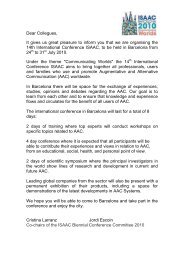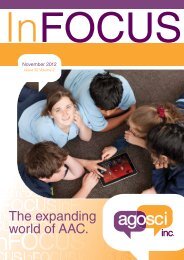ccommunicationo m m u n i c a t i o nppartnersa r t n e r sSupporting Parents to BecomeEffective Communication PartnersThrough ‘School for Parents’:A Holistic Model of Early Intervention Using the Principles ofConductive Educationby Laura Jones (Teacher-Conductor) and Yvette Theodorsen (Speech and Language Specialist)Conductive Education Centre at Carson Street School, Perth, Western Australialaurajones.conductor@hotmail.com24School for ParentsThe Conductive Education Centre at Carson Street Schoolruns a holistic early intervention service known as School forParents. The service includes once or twice weekly half-dayprogrammes for groups of 0-4 year olds with physical and/ormultiple disabilities such as Cerebral Palsy, and for childrenwhose physical development (and often global development) isdelayed such as children with Downs and Angelman’s Syndromes.The service is known as School for Parents (SfP) because theyoung children attend these groups with their parents and theemphasis of the intervention is on both children and parentslearning together. Workshops are also held throughout theyear to provide parents and their extended family or supportnetwork with greater insight into the strategies and activitiesused within the programmes.The SfP services, coordinated by a Teacher-Conductor andSpeech and Language Specialist, are underpinned by theprinciples of Conductive Education and therefore have apedagogical rather than clinical perspective (Withall & Cotter,1996). The central tenant is an open expectation of humanpotential and a belief that all individuals can learn (across allareas of development) if given appropriate conditions. Theultimate goal of Conductive Pedagogy is for individuals to seethemselves as people who ‘can’, who have active, independent,problem solving personalities (Hari, 1996; Kozma, 1995)– essentially, individuals who have the capacity to meet thedemands of their daily lives (Hari & Akos, 1988). Clearly, theability to be an effective, active and competent communicatoris critical to the development of an active ‘can do’ personality.The vast majority of children attending SfP groups have severecommunication impairments (97%). In order to learn the skillsnecessary for competent communication it is imperative thatthese children have good communication partners around themwho can support their language development effectively. TheConductive Education Centre at Carson Street School promotesthe use of aided language stimulation strategies (Goosens,Crain & Elder, 1992) across all of its services in order to supportcommunication development. In our experience, implementingaided language stimulation (ALS) within the SfP groups andproviding training on ALS for parents and their extendedsupport networks is essential if we want those in our children’severy day environments to become better communicationpartners.Aided Language Stimulation (ALS)ALS involves a combination of strategies which expose childrento the use of aided symbols within meaningful, purposefulcommunicative interaction. When describing ALS strategieswithin our workshops, we use the acronym MORSE to helpparticipants remember the range of strategies, explaining thatwe need to create Opportunities for MORSE - Modelling,Observing and Responding, Scaffolding and Expanding (Porter,2007).Creating OpportunitiesWithin SfP we ensure the learning environment supports theimplementation of ALS and therefore supports aided languageacquisition. Aided language displays (ALDs) presentingappropriate vocabulary across a range of communicativefunctions (including comments, requests, questions, objectionsand exclamations etc) are readily available across the wholedaily routine. ALDs for specific activities are kept where thoseactivities take place. In so doing, we have tried to “engineerthe environment” (Porter & Kirkland, 1995, p.97) because werecognise that communication needs to occur in all activities inall positions (Burkhart & Porter, 2006). By ensuring the ALDsare always available, we are not only supporting the children’sprogress towards communicative competence but also theparents’ progress towards being a good communication partner– they have plenty of opportunities to practise using the ALDswithin the supportive context of the group and can seek helpeasily if they need it. They are able to learn from the modelsprovided both by the staff and other parents in the group usingthe ALDs. By ‘engineering’ the group environment (Goosens,Crain & Elder, 1992), we provide ideas to parents and theirsupport networks on how they can similarly set up theirchild’s other environments to create ongoing opportunities forcommunication development.We provide varied, meaningful, fun activities that encourageand entice communication – not just for the children but forfamilies too. Depending on the needs of the groups, we willfocus activities to stimulate particular communicative functions
ccommunicationo m m u n i c a t i o nppartnersa r t n e r sSupporting Parents... (cont)(such as asking questions or making comments on new toys,encouraging requests for a turn, developing metacommunicationskills within pretend play etc).The ALS workshops we provide for parents, who are encouragedto bring siblings, extended family members, carers and otherprofessionals involved with their children, create excellentopportunities for participants to learn about and be exposedto ALS in action.ModellingIt is important that good communication partners rememberthat competent communication is not innate, rather it mustbe learnt, and to be learnt, it must be taught (Light, 1997).All children need huge amounts of receptive input before anyexpressive output is achieved in language terms and childrenwho need to learn to use AAC methods must equally be exposedto high quality examples of their AAC system of language inuse. As we know children learn to communicate in the waythey experience their system of communication being used(Beukelman & Mirenda, 1998; Porter, 2007; Porter & Kirkland,1995).Throughout group sessions, we emphasise to families the needto model multiple modes of communication so that their childcan learn to be flexible, adopting whatever communicationtool will allow them to be most effective and efficient at thatparticular moment. The group situation allows families tobecome confi dent that the use of AAC will not prevent speechdeveloping and that the use of symbols will not discouragesigning, as they can learn from the experiences of otherfamilies within the group, as well as information provided bythe Teacher-Conductor and Speech Pathologist.We model the use of aided symbols by pointing to theappropriate symbols as we speak – on ALDs and in multi-levelcommunication books. We use ‘group’ communication booksbased on the ‘Pragmatically Organised Dynamic Display’(PODD) templates (Porter, 2007) which include pragmaticfunctions and activities used specifically within the groupsessions. The group books are matched in their vocabularyand visual presentation to the general needs of the children ineach group, taking into account their current communicationskills and those they need to develop. We also model the useof partner-assisted scanning to demonstrate to both childrenand their communication partners how to use these methodsto access the children’s own individualised PODD books. Weoften use small torches to further highlight and draw visualattention to the symbols as we point.Modelling is also applied to the use of voice outputcommunication aids, including simple single message devices,multiple message devices and more complex dynamic displaydevices because access to technology itself is not the answer(Jones, 2007; Millar & Aitken, 1996). Input must be providedto enable children to use these technologies for competentcommunicative output. On all displays, low or high tech,we always seek to provide enough vocabulary to meet thechildren’s current communication needs, as well as to enablecommunication partners to model vocabulary for furtherdevelopment. Group sessions allow parents to learn how tomodel a range of devices from the group leaders as well asother parents and, more importantly, they have the opportunityto practise this skill in a supportive environment.When providing workshops, we show videos clips ofcommunication partners modelling and children using varioustypes of PODD communication books, ALDs and voice output devices taken from current and previous SfP groups, anda training package from Education Queensland (2001). Weallow time for parents to practise saying messages whilstmodelling the appropriate symbols on ALDs and in variouscommunication books, so they experience modelling in a nonconfrontingway.Observing and RespondingWe teach parents that, in order to be able to observe theirchildren’s communication and potential for development, weneed to start with a system that can be easily modelled by allcommunication partners across all environments and aspectsof their daily routine. For example, when a child fi rst comes25





